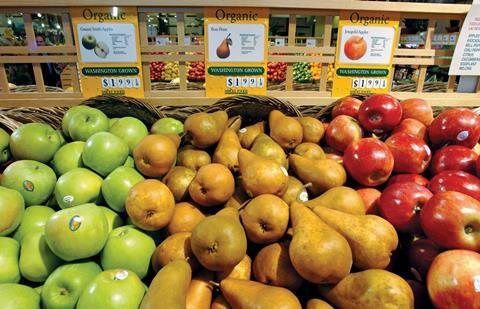
While top-fruit retail prices are lower than suppliers would like, strong promotional activity by supermarkets is at least giving a significant boost to volume sales.
The top-fruit market is currently worth £1.1 billion, up 0.6 per cent this year but with volumes rising an impressive 7.3 per cent [Kantar Worldpanel, 52 w/e 24 May 2015].
Lower prices have been the chief driver of the market performance, according to Jo Mumford, category insight manager at Chingford Fruit. “Deflated year-on-year net average retail prices within the market remain prevalent this season, whereas this time last year we saw base retail inflation having a detrimental effect on volume. Good levels of sales have been achieved so far this year on retails that remain consistent week after week.”
Adrian Barlow, chief executive of English Apples & Pears, describes the volume increase as “tremendous”, though he stresses that low prices have been the result of a complicated set of circumstances across Europe. “The whole industry has been affected by the problems on the continent because of a large European crop and the Russian ban,” he explains.
“That caused a great deal of panic, particularly as people suddenly thought they’d need to empty stores rapidly for the new crop and had to increase sales and almost accepted any price.”
Despite the glut of available fruit, Barlow says the multiples have been “extremely supportive” of English fruit and paid prices considerably higher than they could have, had they switched to overseas sourcing this season.
The ongoing price war and retailers’ price-matching initiatives are continuing to have a suppressing effect on the top-fruit market, and there is little to suggest anything will change in the near future. Every Day Low Pricing strategies are much more prevalent nowadays than pure promotional mechanics, says Mumford, who adds that the discounters are using top fruit to emphasise their value credentials to an even greater extent this season.
While it’s too early to make concrete predictions for the new English season, there are encouraging noises coming from growers in the wake of favourable weather conditions. Barlow describes the current crop as “slightly inconsistent”, adding: “There has been very good pollination and fruit set, though there has been a bit of hail damage. It is important we see an improvement in the weather in the next few weeks, as it hasn’t helped skin finish.”
Sean Finlayson, farm manager of Farmcare’s Highland Court Estate, says the overall picture is good: “I’m pleased to see some warmer, humid weather coming through, which, of course, is helpful during this time for cell expansion, so we’re keen to see the sun until the end of June.
“Highland Court is looking promising, with a few exceptions. Pears were affected by a couple of hail events and it remains to be seen whether it will be worth hand-selecting the crop.”
Farmcare grows 250ha of apples and 15ha of pears, but while Finlayson says the company is looking at investing in intensive pear orchards, he also describes it as a ‘catch 22’, with “huge demand for English-grown pears, but the willingness to pay for local produce doesn’t always reflect that demand.”
Finlayson reports that newer, commercial varieties are performing well, with high hopes for Wellant, Opal, Sweetie and Junami, while Mumford adds that overall production is growing as new orchards have been planted with higher colour clones.
“Some growers are further ahead of the curve than others and this will improve the overall appearance of apples on the shelf for the end consumer,” she says. “Some varieties like Cox will slowly disappear as the volumes are replaced with more popular apples.
“It will be interesting to see if any changes to the core varietal mix occur in the longer term. This will clearly remain subject to many different factors.”



